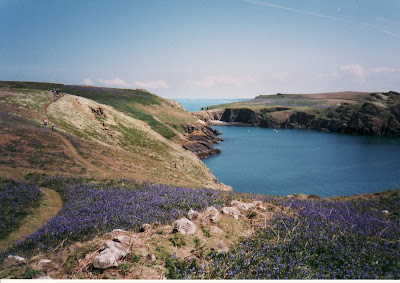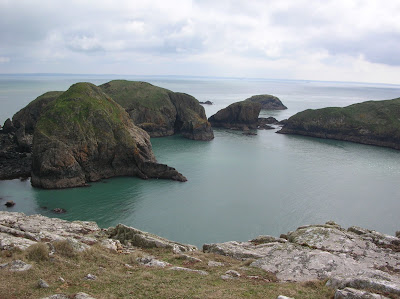Skomer Island is located at the western end of the Marloes Peninsula in Pembrokeshire. The island (not including The Neck at the eastern end of the island, which is only joined to the rest of the island by a narrow isthmus) is approximately 1.5 miles from east to west by 1.25 miles from north to south. The highest point on the island is 79 metres above sea level. There are cliffs round the whole island but the top of the island is relatively flat.
Passenger boats to Skomer depart from Martin's Haven near Marloes and land at North Haven on Skomer. The crossing time is approximately 10 minutes. 87 steps lead from the landing place up to the top of the island, which is is open to visitors from 1st April or Good Friday (whichever is earliest) until the end of September. There is a toilet on the island but no other facilities. You can buy bottles of water. It is not possible to book tickets in advance and a maximum of 250 visitors per day are allowed to visit Skomer, so my advice is to arrive at Martin's Haven early in the day. The first boat departs at 10am. Dogs are not allowed on the island
Skomer has been inhabited since at least the Iron Age. The island is covered with the remains of settlements, field systems and cairns from a variety of time periods. The Harold Stone at the eastern end of the main part of the island is a standing stone, which may date from the Iron Age. The Vikings called the island Skalmey (skalm means a short sword or a cut/cleft and ey means island). The name probably refers either to the fact that the island is almost cut in two and only joined by a narrow isthmus between North and South Havens or to The Wick in the south of the island, which is a deep cut into the island.
Skomer was farmed until 1950. In the 13th century it was a rabbit warren for fur and meat. The volcanic soils on the island are not naturally very fertile but two lime kilns on the island produced lime, which could be used as a fertilizer. The present farmhouse was built c1840 on the site of an earlier (c1700) building. It is now in ruins but some of the outbuildings have been converted into hostel style accommodation and it is possible to stay the night on the island. Overnight visitors staying during the bird breeding season get the chance to see the Manx Shearwaters returning to their burrows under the cover of darkness. They do this to avoid predators such as Great Black Backed Gulls.
In 1959 Skomer was purchased by the West Wales Field Society and the Nature Conservancy. It has been a National Nature Reserve since 1959 and it was later designated as a Site of Special Scientific Interest. The West Wales Field Society later changed its name to the Wildlife Trust of South and West Wales. They are the current managers of the island.
In the breeding season the island is home to 22,000 puffins and 316,000 pairs of Manx Shearwaters. Together with the Manx Shearwaters which nest on the neighbouring island of Skokholm, this is the largest concentration of this bird in the world. There are also various types of gulls, razorbills, guillemots, kittiwakes and fulmars. You can get very close to the puffins - they show no fear of humans. They nest in burrows. If you haven't encountered puffins before you will probably be surprised how small they are.
The Skomer Vole, which is a type of bank vole, is unique to the island. Atlantic grey seals can be seen in the sea around the island.
Puffin outside his or her burrow
The Wick
South Haven looking towards The Neck
South Coast looking towards The Wick and the Mew Stone
Bluebells
I always thought that bluebells only grew in lightly shaded woods but Skomer doesn't have any trees on it and yet more or less the whole island is covered in them. A month or so later and parts of the island are covered in red campion. The island was originally covered in oak and birch trees, which were cleared by early settlers and the bluebells are apparently left from this time.
Puffins
The Spit, Pigstone Bay
Limekiln near the Harold Stone looking towards The Neck
Harold Stone
Old Farm
Skokholm from Skomer
Trig Point above the Old Farm
Razorbills and Guillemots
The Wick
Garland Stone
Puffin
Puffin
North Haven
North Pond
Ruined cottage near the Old Farm
The Neck across a sea of bluebells and red campion







































